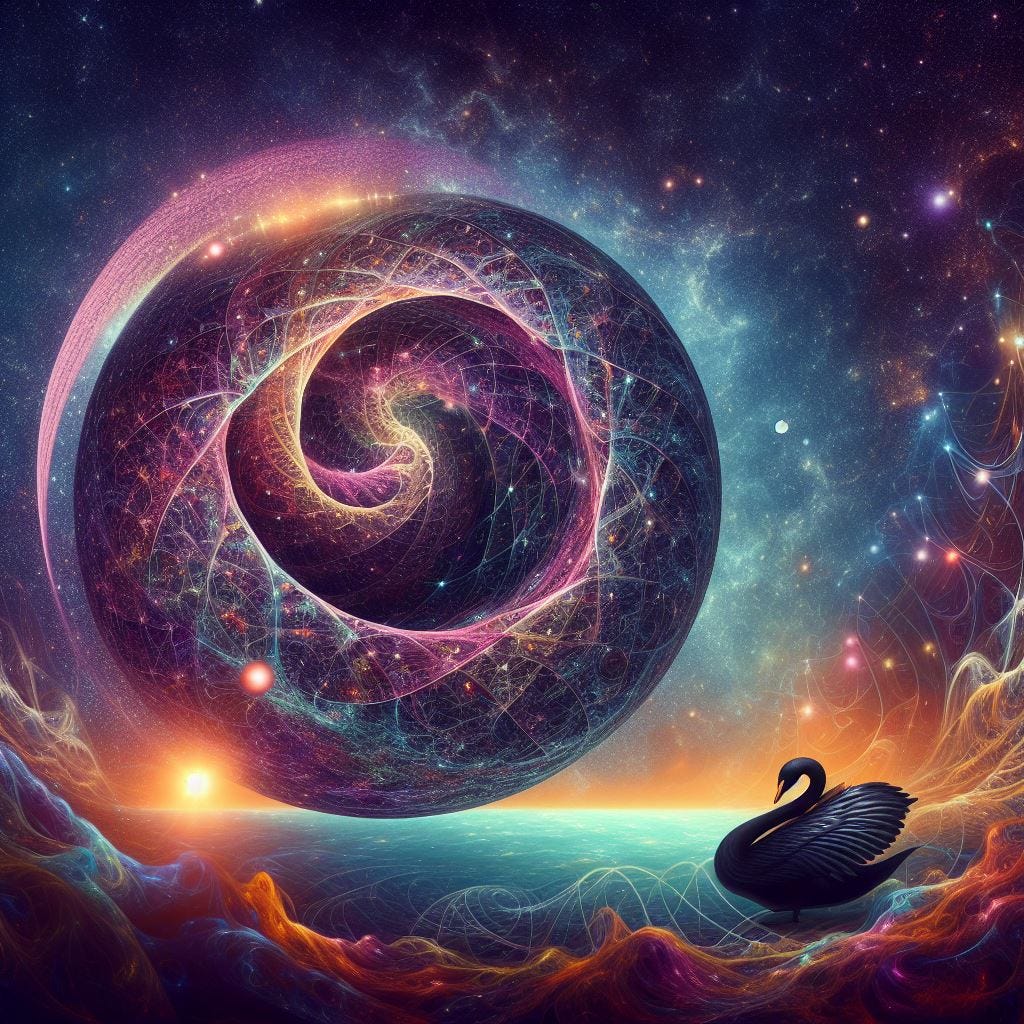Shraddha, Calabi-Yau Manifolds, Black Swans, and the Allure of the Impossible.
On Courage, Intuition, and Theoretical Leaps into the Unknown.
The Calabi-Yau varieties are mathematical objects extremely complex that appear in the theory of the superstrings, a theory that aspires to reconcile quantum mechanics with general relativity. These varieties serve to model the hypothetical extra dimensions of spacetime, beyond the usual three spatial dimensions and a temporary.
According to the theory of the superstrings, the punctiform particles are in reality tiny vibrating strings in a hyperspace to 10 or 11 dimensions. 6 or 7 of these dimensions are rolled up on extremely small scales, under the reach of our instruments. The Calabi-Yau varieties provide the mathematical model to describe the shape of this ultracompact rolling.
The extra dimensions foreseen by the string theory are so small as to escape our observation. Yet, they alter subtly the properties of the particles and the forces that we observe. It is as if a deeper reality existed that influences what we perceive, but that we cannot experience directly.
Here comes into play the concept of "black swan" introduced by the philosopher and mathematician Nicholas Taleb. A black swan is an extremely rare and improbable event, impossible to foresee, that has an enormous impact. The metaphor refers to the fact that in Europe it was believed that all swans were white until the black Australian swan was discovered.
The extra dimensions predicted by string theory are, in a sense, "black swans": events difficult even just to imagine, that would subvert our beliefs about spacetime if ever observed. Just like a black swan, their existence is predicted by the theory, but we still cannot verify it experimentally.
Physicists look for indirect clues of these hidden dimensions, for example through tiny quantum effects. But for now, we have no definitive proof. Experiments would be needed at extremely high energies, similar to those of the Big Bang, to probe these inaccessible realms.
In the absence of empirical evidence, theoretical physicists rely on complex mathematical models, such as Calabi-Yau manifolds, to describe these hypothetical multidimensional spaces. It is a bold and counterintuitive speculation, which however could reveal deeper truths.
Here comes into play the concept of shraddha in Vedanta philosophy. In the Upanishads, Hindu sacred texts, shraddha is defined as a profound faith and conviction that transcends pure rationality. It is not blind faith, but a form of intuition that allows contemplating realities otherwise inconceivable.
Shraddha is what allows the spiritual seeker to open up to truths that go beyond the limits of the rational mind. It requires letting go of one's certainties to open up to possibilities never imagined before. It is a trust in ultimate reality, even when its true face remains hidden.
In a sense, theoretical physicists who develop models like Calabi-Yau manifolds are making an act of shraddha. Relying on mathematics, they explore radically unknown realms of existence, inaccessible to our senses and our ordinary reason.
They have to let go of common notions like three-dimensional space and linear causality, to contemplate the possibility of dimensions rolled up on minuscule scales and of particles vibrating in multiple dimensions. It is a conceptual leap that requires a profound act of faith in the ability of the human mind to probe the ultimate mysteries of reality.
Now, a concluding reflection that ties together these three concepts: Calabi-Yau manifolds, black swans and shraddha.
The exquisitely mysterious Calabi-Yau manifolds are perhaps what is most similar, in contemporary theoretical physics, to real "black swans": extremely rare and improbable events that, if observed, would have the power to radically overturn our vision of reality. These mathematical objects model dimensions of spacetime so alien as to challenge the imagination. Yet, if they existed, they would secretly shape the behaviour of the familiar particles and forces. They represent the unknown that influences the known. One has to abandon the reassuring territory of three spatial dimensions and classical physics, to venture into multidimensional mathematical spaces governed by quantum laws.
It is a speculative pilgrimage towards the inconceivable. Yet, paradoxically, this "leap into the dark" may prove to be the only way to shed light on the deepest secrets of the cosmos. Because it is at the confines of the imaginable that the black swans hide, capable of changing the paradigm of our knowledge.
The Calabi-Yau manifolds, in their mind-boggling mathematical beauty, are the symbol of this faith in the unexpected. They remind us that reality always has the power to surprise us and refute our most entrenched certainties. To unveil its mysteries requires courage, intuition and that special form of faith which is shraddha: the conviction that there are truths out there that infinitely exceed our present understanding.
I have woven tales to share, for any who care to read them. My books await you on Google Books. Check also my stories on Medium.com.




